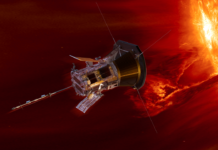Comet C/2023 A3 (Tsuchinshan-ATLAS): A Celestial Event Captured from Space
In a remarkable display of celestial beauty, NASA astronaut Matthew Dominick has captured a stunning timelapse photograph of Comet C/2023 A3, also known as Tsuchinshan-ATLAS, from the International Space Station (ISS). This image was taken as the space station orbited 272 miles above the South Pacific Ocean, southeast of New Zealand, just before sunrise on September 28, 2024. At that moment, the comet was approximately 44 million miles away from Earth.
Discovery and Characteristics of the Comet
Comet C/2023 A3 is a fascinating astronomical object with a story that stretches back to ancient times. Despite its age, it was only discovered in 2023 as it made its journey into the inner solar system on its highly elliptical orbit. This is the first time in recorded human history that the comet has ventured this close to the sun, providing a unique opportunity for observation and study.
Beginning in mid-October 2024, this comet is expected to become visible low in the western sky shortly after sunset. If the comet’s tail catches enough sunlight, it might even be discernible without any visual aids. However, for a more detailed view, using binoculars or a small telescope is recommended. The optimal period for observing this celestial event is from October 14 to October 24. During this timeframe, skywatchers can look forward to a potentially spectacular view of a comet as it graces our skies.
Understanding the Oort Cloud
The origins of Comet C/2023 A3 can be traced back to the Oort Cloud, a mysterious and vast region that surrounds our solar system. The Oort Cloud is thought to be a massive, spherical shell composed of icy remnants from the early solar system. These fragments can range in size from small mountains to objects even larger. Situated far beyond Pluto and the furthest reaches of the Kuiper Belt, the Oort Cloud may contain billions, or even trillions, of such icy bodies.
The Oort Cloud remains largely theoretical, as it is too distant and sparse to be observed directly. However, it is believed to be the source of long-period comets, like Comet C/2023 A3, which take thousands or even millions of years to complete an orbit around the sun. The journey of these comets from the Oort Cloud into the inner solar system provides scientists with valuable insights into the early solar system’s composition and dynamics.
The Significance of Comet Observations
Observing comets like C/2023 A3 offers a unique glimpse into the building blocks of our solar system. Comets are often referred to as "dirty snowballs" because they are made up of a mix of ice, dust, and rocky material. As they approach the sun, the heat causes them to release gases and dust, forming a glowing coma and often a spectacular tail that stretches away from the sun.
These features make comets not only visually stunning but also scientifically significant. By studying the composition of comets, scientists can learn more about the conditions and materials present during the formation of the solar system. Additionally, comets can provide clues about the processes that led to the development of planets and other celestial bodies.
How to Observe Comet C/2023 A3
If you are interested in witnessing this astronomical event, here are some tips for observing Comet C/2023 A3:
- Timing: The best time to observe the comet is from October 14 to October 24, shortly after sunset. During this period, the comet should be visible low in the western sky.
- Location: Find a location with a clear view of the western horizon. Avoid areas with light pollution, such as city lights, to improve your chances of seeing the comet.
- Equipment: While the comet might be visible to the naked eye, using binoculars or a small telescope will enhance your viewing experience, allowing you to see more details of the comet’s tail and coma.
- Weather: Check the weather forecast to ensure clear skies on the nights you plan to observe the comet. Cloudy or overcast conditions will hinder your ability to see the comet.
A Unique Opportunity for Skywatchers
Comet C/2023 A3 presents a rare and exciting opportunity for both amateur and professional astronomers. Its appearance in our skies is a reminder of the dynamic and ever-changing nature of our solar system. For those interested in astronomy, this event is not to be missed, as it offers a chance to witness a piece of cosmic history.
Conclusion
The capture of Comet C/2023 A3 by astronaut Matthew Dominick from the ISS is a testament to the wonders of space exploration and observation. As the comet continues its journey through our solar system, it provides a beautiful spectacle for skywatchers and a valuable subject of study for scientists. By understanding and appreciating these celestial events, we gain a deeper appreciation for the vast and intricate universe we inhabit.
For more information on observing Comet C/2023 A3 and other skywatching tips, you can visit NASA’s official website and their dedicated skywatching page.
For more Information, Refer to this article.

































